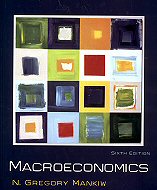|
Macroeconomics - Sixth Edition
|
|
N. Gregory Mankiw
|

|

What's New in the Sixth Edition?
[…] This six edition retains the same broad structure as the fifth [...]. The book has been updated, but I have also refined the pedagogy and coverage. Although the basics of macroeconomic theory are much the same as they were four years ago, enough has changed in the details and practice of macroeconomics to warrant putting out a new edition.
Here is a list of the major changes in the order that they appear:
* Chapter 1 has a new FYI box on Noble-Prize-winning macroeconomists.
* Chapter 2 has a new section that discusses the establishment survey of
labor-market conditions and contrasts it with the household survey.
* Chapter 3 has incorporated the Cobb-Douglas production function into the main text, rather than leaving it for an appendix. […]
* Chapter 4 has a new FYI box on the role of credit and debit cards in the
monetary system.
* Chapter 5has a new FYI box that explains the irrelevance of bilateral trade balances, a new section motivating the assumption of a small open economy. […]
* Chapter 6 has a new Case Study on the characteristics of minimum- wage workers. It also has a much expanded discussion of European labor markets. […]
* Chapter 7 has a new section discussing alternative perspectives on the
role of population growth in the process of economic growth.
* Chapter 8 has a new Case Study analyzing the impact of trade on
growth, as well as a new section on the role of institutions in fostering
Economic prosperity. […]
* Chapter 9 begins with a more extensive discussion of business-cycle
facts to introduce the subject of short-run economic fluctuations.
* Chapter 12 has a new section on the "impossible trinity" - the
inconsistency of allowing free flows of capital, conducting independent
monetary policy, and fixing the exchange rate. […]
* Chapter 15 has a thoroughly revised Case Study on the outlook for fiscal policy and a new FYI box on how taxes affect incentives.
* Chapter 16 contains a new Case Study about what behavioral
economics has to say about policies to increase saving.[…] […] […]
|
|
